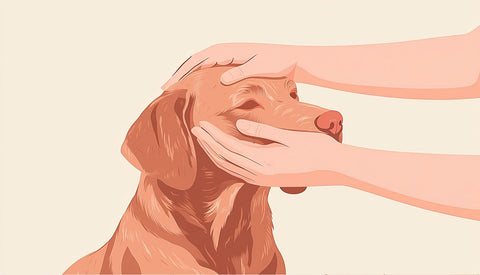Dogs scratching is normal, but if they're doing it a lot, or it seems to bother them, there's probably a reason. Some dogs might lick or chew instead of scratching, so keep an eye out for red, sore skin, patches of missing fur, or brown stains from saliva where they've been licking.
Itching, or pruritus, is a symptom not a problem in itself. It's actually one of the main reasons owners bring their dogs to the vet!
Many dog owners face the same challenge, their dog scratching but no fleas. So, you're not alone, many other things could be making your dog uncomfortable.
Fleas are tricky and they're super common! They also breed faster in warm weather, but before you assume it's not fleas, there are a few things you need to do.
How Do You Check for Fleas on Your Dog?
Fleas love to hide, especially in thick or dark fur. You're more likely to find the eggs, larvae, and pupae (the different stages of a flea's life) than the adult fleas themselves. Even though adults only make up about 5% of the flea population, a single flea can lay 40-50 eggs each day! That means just a few adult fleas can quickly start a big problem. So, even if you don't see a flea, it doesn't mean they aren't there.
To check for fleas, use a fine-toothed comb and look for tiny, dark specks of flea faeces. These are usually found around the neck and tail base. Putting these specks on a damp cotton wool pad will turn them red because they contain blood.
Is the Itch in One Spot?
If the itching is in one particular place, it's worth investigating further. Look closely for any injuries, matted fur, objects like splinters stuck in their fur, or bites from insects or ticks. If your dog is only bothering their ears, you'll need a vet to check inside the ear canals for signs of inflammation, infection or even things like grass seeds.
Flea Treatment Didn't Work? Could It Still Be Fleas?
Even if you've used a flea treatment, your dog could still be suffering from fleas. Flea treatments need to contain the right ingredients and be used regularly. Gaps in protection give fleas a chance to bite and lay eggs in your home. Remember, 95% of a flea's life happens in your home's environment, so effective home treatments are important.
Sometimes, natural solutions can offer a gentle approach to flea prevention. For example, the Waggy Essentials Natural Bug Off Spray is a UK-made repellent that's specially formulated for dogs and produced by experienced dog groomers at Waggy Wagon in London. This spray uses essential oils like cedarwood, sandalwood, and eucalyptus to naturally repel fleas and ticks. It's safe to use on your dog's coat, just make sure to avoid the eye area. A quick spray before a walk is a great way to give your dog extra protection.

There are so many cheap flea products out there, and they all use different active ingredients. Some products sold in shops or online haven't been tested thoroughly for safety and effectiveness. It's best to get advice from your vet, especially if you're dealing with a flea outbreak. Vets can also recommend products that protect against other parasites like ticks or lungworms, and they'll help you choose something that fits your dog's needs and your lifestyle.
Many flea treatments only work after the flea bites your dog. If your dog has an allergy to flea saliva “flea allergic dermatitis”, even a few fleas can cause a lot of itching. Just one flea can bite up to 400 times a day!
Dog Scratching All Over! What Could It Be?
If your dog is scratching all over, there are a few common culprits: parasites, infections, and allergies. We've already talked about fleas, which are the most common parasite, but there are also many other types of…
- Mites
They can be a real nuisance for dogs, and sometimes they're hard to see without a magnifying glass. Some types, like Sarcoptic mites, are known for causing intense itching and scabby patches, often around the ears, chest, and limbs.
These mites are contagious and can spread between dogs and even to humans.
Another type, commonly found in rabbits, can occasionally affect dogs. These mites look like specks of dandruff that move around and can cause itching in sensitive dogs, although often they don't. While they can't live on humans, they can irritate human skin.
Demodex mites are another type that can cause scaling and hair loss, either in specific areas or all over. Some forms cause itching, while others don't. These mites aren't contagious to other animals or humans, but a secondary skin infection can lead to intense itching.
If you've ruled out everything else, it's likely your dog is dealing with...
- Skin Infections
Skin infections can be caused by bacteria and they often happen when a dog's skin barrier isn't working properly because of an underlying allergic skin disease. In fact, a skin infection might be the first sign that your dog has allergies.
Bacterial infections often appear in moist areas like the ears, feet, and groin, and look like round, scaly patches, pimples, or oozing sores. Sometimes, they can affect the whole body. Yeast infections tend to be more greasy and often affect the ears. Both types of infection can cause intense itching, so they need treatment, but it's important to address the underlying allergy.
Remember, preventing infections is key to managing allergic skin diseases in the long run.
- Allergic Skin Reactions
Contact allergies, while not as common, can happen if your dog reacts to something new, like a shampoo or washing powder, etc…
Flea allergy dermatitis, as we mentioned, is pretty common. Dogs with this allergy typically have lesions on their rump, back, and neck.
The other two main types of allergies are Canine atopic disease, often called “Atopy” or “Atopic Dermatitis” and Cutaneous adverse food reaction, or “Food Allergy”. Atopy is a reaction to environmental allergens like pollen, causing seasonal symptoms, or house dust mites, causing year-round signs. Food allergies are reactions to specific foods, usually occurring throughout the year.
These two types of allergies have very similar signs, making them hard to tell apart! To make things even more complicated, many dogs have a mix of allergies. Usually, skin changes and itching are widespread, affecting the tummy and face more often, but they can also be localised. Food allergies are more likely in dogs less than a year old, but they can happen at any age. They also cause gut problems in about one-third of dogs. Atopy usually starts between six months and three years old.
Your vet might suggest a strict elimination food trial if they suspect a food allergy.
Unfortunately, allergic skin diseases can't be cured, only managed. This can be incredibly frustrating for owners, as it's a lifelong commitment that takes time and money.
Final Thoughts,
We hope this blog has helped you understand why your dog might be scratching so much. Using a safe and effective treatment is important for keeping your pooch and home protected. If your dog is still itchy after using a treatment, it's best to visit your vet to find out what's going on.
For a natural approach to flea and tick prevention, consider our selection of organic and natural products. 100% safe for your pet, family, and furniture.



